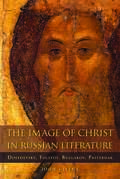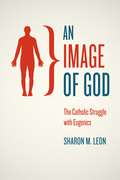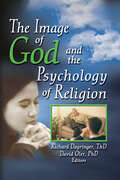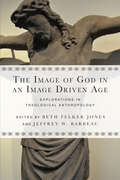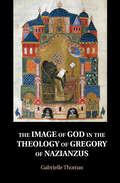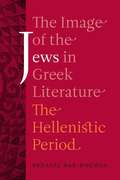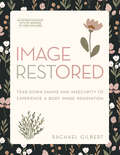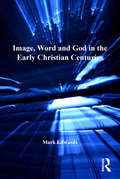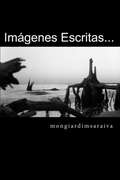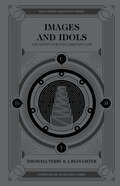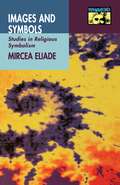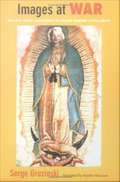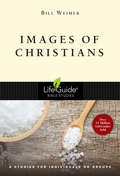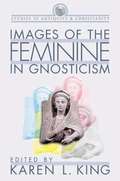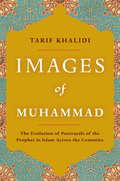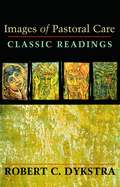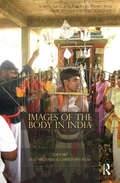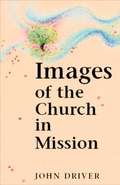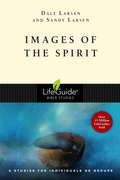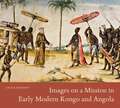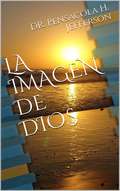- Table View
- List View
The Image of Christ in Russian Literature: Dostoevsky, Tolstoy, Bulgakov, Pasternak (NIU Series in Slavic, East European, and Eurasian Studies)
by John GivensVladimir Nabokov complained about the number of Dostoevsky's characters "sinning their way to Jesus." In truth, Christ is an elusive figure not only in Dostoevsky's novels, but in Russian literature as a whole. The rise of the historical critical method of biblical criticism in the nineteenth century and the growth of secularism it stimulated made an earnest affirmation of Jesus in literature highly problematic. If they affirmed Jesus too directly, writers paradoxically risked diminishing him, either by deploying faith explanations that no longer persuade in an age of skepticism or by reducing Christ to a mere argument in an ideological dispute. The writers at the heart of this study understood that to reimage Christ for their age, they had to make him known through indirect, even negative ways, lest what they say about him be mistaken for cliché, doctrine, or naïve apologetics. The Christology of Dostoevsky, Leo Tolstoy, Mikhail Bulgakov, and Boris Pasternak is thus apophatic because they deploy negative formulations (saying what God is not) in their writings about Jesus. Professions of atheism in Dostoevsky and Tolstoy's non-divine Jesus are but separate negative paths toward truer discernment of Christ. This first study in English of the image of Christ in Russian literature highlights the importance of apophaticism as a theological practice and a literary method in understanding the Russian Christ. It also emphasizes the importance of skepticism in Russian literary attitudes toward Jesus on the part of writers whose private crucibles of doubt produced some of the most provocative and enduring images of Christ in world literature. This important study will appeal to scholars and students of Orthodox Christianity and Russian literature, as well as educated general readers interested in religion and nineteenth-century Russian novels.
An Image of God: The Catholic Struggle with Eugenics
by Sharon M. LeonDuring the first half of the twentieth century, supporters of the eugenics movement offered an image of a racially transformed America by curtailing the reproduction of “unfit” members of society. Through institutionalization, compulsory sterilization, the restriction of immigration and marriages, and other methods, eugenicists promised to improve the population—a policy agenda that was embraced by many leading intellectuals and public figures. But Catholic activists and thinkers across the United States opposed many of these measures, asserting that “every man, even a lunatic, is an image of God, not a mere animal."In An Image of God, Sharon Leon examines the efforts of American Catholics to thwart eugenic policies, illuminating the ways in which Catholic thought transformed the public conversation about individual rights, the role of the state, and the intersections of race, community, and family. Through an examination of the broader questions raised in this debate, Leon casts new light on major issues that remain central in American political life today: the institution of marriage, the role of government, and the separation of church and state. This is essential reading in the history of religion, science, politics, and human rights.
The Image of God and the Psychology of Religion
by Richard L Dayringer David OlerWhat are the implications of a client&’s image of God?Improve your confidence-and your practice skills-by enhancing your knowledge of how individuals are likely to perceive God, and of how those perceptions impact the way they function as human beings. Theologians have long speculated and theorized about how humans imagine God to be. This book merges theology with science, presenting empirical research focused on perceptions of God in a variety of populations living in community and mental health settings. Each chapter concludes with references that comprise an essential reading list, and the book is generously enhanced with tables that make data easy to access and understand. "Liberating Images of God" discusses the constriction and impoverishment of God images due to the traditional restrictions of God images to those that are male and personified. This chapter examines the potential for the client and counselor&’s co-creation of images of God which embrace the feminine as well as the masculine, the nurturer as well as the warrior, and the natural world in all its dimensions as well as the human world, to liberate, enrich, sustain, and transform the client&’s relationships with God and with him/herself. "Attachment, Well-Being, and Religious Participation Among People with Severe Mental Disorders" examines the relationship between attachment states of mind and religious participation among people diagnosed with severe mental illness. "Concepts of God and Therapeutic Alliance Among People with Severe Mental Disorders" explores the transferential aspects of God representation among severely mentally ill adults. It highlights research on the relationship between a patient&’s image of God and that patient&’s working relationship with his/her case manager, and discusses the implications for clinical practice of those findings. "The Subjective Experience of God" presents a theory about the psychological basis for the experience of God that argues that this experience is essentially a form of projection and as such is an internal event that does not exist independent of an individual&’s psyche. This chapter draws a distinction between faith in a particular belief-namely, faith in the existence of a loving, omnipotent God-and an attitude of faith, which is the basis for experiences of transcendence. "Relationship of Gender Role Identity and Attitudes" presents the results of a study in which nearly 300 Catholic attendees at three university Catholic centers completed the Bern Sex Role Inventory, the Attitudes Toward Women Scale, and the Perceptions of God Checklist. This chapter looks at images of God as masculine or feminine, and at the connection for people between the way they perceive God and the way they relate towards men and women. "Reflections on a Study in a Mental Hospital," brings you groundbreaking new research on perceptions of God in an inpatient population. This chapter examines the positive effects (as opposed to the negative effects previously portrayed by the psychological community) of religious belief and practice for residential care patients in a psychiatric hospital.
The Image of God in an Image Driven Age: Explorations in Theological Anthropology (Wheaton Theology Conference Series)
by Beth Felker Jones Jeffrey W. BarbeauThe Image of God in an Image Driven Agetheosis
The Image of God in the Theology of Gregory of Nazianzus
by Gabrielle ThomasGregory of Nazianzus, known best for his Christology and Trinitarian doctrine, presents an incomparable vision of the image of God. In this book, Gabrielle Thomas offers a close analysis of his writings and demonstrates how Nazianzen depicts both the nature and experience of the image of God throughout his corpus. She argues that Nazianzen's vision of the human person as an image of God is best understood in light of biblical and extra-biblical themes. To establish the breadth of his approach, Thomas analyzes the image of God against the backdrop of Nazianzen's beliefs about Christology, Pneumatology, creation, sin, spiritual warfare, ethics, and theosis. Interpreted accordingly, Nazianzen offers a dynamic and multifaceted account of the image of God, which has serious implications both for Cappadocian studies and contemporary theological anthropology.
The Image of the Jews in Greek Literature: The Hellenistic Period
by Bezalel Bar-KochvaExamining the attitudes of Hellenistic Greek authors and scholars toward the Jewish people, and their religion and customs, over a span of 270 years, this book focuses on twelve authors from whom we have fragments and testimonials referring to the Jews.
Image RESTored - Includes Six-Session Video Series: Tear Down Shame and Insecurity to Experience a Body Image Renovation
by Rachael GilbertThis whole-person, interactive approach to body image includes coloring sheets, journaling prompts, and therapist insights that ground you in God&’s love and build you up in truth. Are you tired of being at war with your body—and with your thoughts about your body? Rachael Gilbert struggled with shame when she didn&’t measure up to her dream body image. Then, as a fitness instructor and licensed counselor specializing in disordered eating, she realized how many of us bury the same painful insecurities. But keeping up appearances is exhausting. We need restoration from the inside out. In Image RESTored, Rachael offers professional guidance, coloring pages, Scripture, prayers, journaling prompts, and a link to online teaching videos to help you experience true freedom. See your whole self in a new way as you learn: A biblical perspective on eating, weight loss, fitness, and self-confidence rooted in God&’s love. Counselor-inspired strategies to help you appreciate how God made you. How to reframe stories that formed your attitude toward your body. Tools for overcoming comparison and trauma. Ways to use thoughts and feelings so they help you rather than sabotage you. Rich with spiritual and therapeutic insights, this Christian body image workbook calls you to experience healing and wellness that starts with knowing God&’s love for you—mind, soul, body, and spirit. Presented by Esther Press: Books for Courageous Women This interactive study guide includes a free QR code and URL to access all six videos, plus additional content for engaging study as a group or on your own. To aid you in your planning, following are the session titles and video run times: 1 Counselor's Cornerstone / Video Chat One 8:41 2 Counselor's Cornerstone / Video Chat Two 9:02 3 Counselor's Cornerstone / Video Chat Three 8:23 4 Counselor's Cornerstone / Video Chat Four 7:10 5 Counselor's Cornerstone / Video Chat Five 8:53 6 Counselor's Cornerstone / Video Chat Six 7:20
Image, Word and God in the Early Christian Centuries (Studies in Philosophy and Theology in Late Antiquity)
by Mark EdwardsChristianity proclaims Christ and the incarnate word of God; the Bible is described as the Word of God in both Jewish and Christian tradition. Are these usages merely homonymous, or would the ancients have recognized a more intimate relation between the word incarnate and the word proclaimed? This book investigates the concept of logos in pagan, Jewish and Christian thought, with a view to elucidating the polyphonic functions which the word acquired when used in theological discourse. Edwards presents a survey of theological applications of the term Logos in Greek, Jewish and Christian thought from Plato to Augustine and Proclus. Special focus is placed on: the relation of words to images in representation of divine realm, the relation between the logos within (reason) and the logos without (speech) both in linguistics and in Christology, the relation between the incarnate Word and the written text, and the place of reason in the interpretation of revelation. Bringing together materials which are rarely synthesized in modern study, this book shows how Greek and biblical thought part company in their appraisal of the capacity of reason to grasp the nature of God, and how in consequence verbal revelation plays a more significant role in biblical teaching. Edwards shows how this entailed the rejection of images in Jewish and Christian thought, and how the manifestation in flesh of Christ as the living word of God compelled the church to reconsider both the relation of word to image and the interplay between the logos within and the written logos in the formulation of Christian doctrine.
Imágenes Escritas…
by Antonio Carlos Mongiardim Gomes Saraiva Elisa Aguilera CormenzanaSobre el autor: Portugués, nacido en Lisboa en el año de 1957. Vive en Brasil desde 1995. Profesor y traductor de lengua Francesa. Artista plástico y Escritor. Publicaciones: Entre el cielo y la tierra (Poesías, crónicas y pensamientos) Una dieta cuántica (Ensayo) Site: http://meujardimpoetico.blogspot.com.br/ Contacto: mongiardimsaraiva@gmail.com Logotipo:
Images and Idols: Creativity for the Christian Life
by Thomas J Terry J. Ryan ListerChristians ought to be leading the way in creativity, but we rarely do. God is the Creator of all things, and He created us in His image. Creativity is woven into the very fabric of our humanity. Therefore, Christians should value and champion creativity as a vital part of our image-bearing role. Instead Christians often don&’t know what to do with creatives and creatives don&’t know what to do with Christianity. On one side you have Christians who neglect or discount art, imagination, and beauty altogether. On the other, you have artists who make idols out of each of these good things. Ryan Lister, a theology professor, and Thomas Terry, a spoken word artist and founder of Humble Beast, team up to help restore the connection between creativity and theology. Images & Idols is a theological and artistic exploration of creativity in the Christian life. It will help creatives build a strong theological foundation for their art, while challenging the church to embrace a theology of beauty and creativity.
Images and Idols: Creativity for the Christian Life
by Thomas J Terry J. Ryan ListerChristians ought to be leading the way in creativity, but we rarely do. God is the Creator of all things, and He created us in His image. Creativity is woven into the very fabric of our humanity. Therefore, Christians should value and champion creativity as a vital part of our image-bearing role. Instead Christians often don&’t know what to do with creatives and creatives don&’t know what to do with Christianity. On one side you have Christians who neglect or discount art, imagination, and beauty altogether. On the other, you have artists who make idols out of each of these good things. Ryan Lister, a theology professor, and Thomas Terry, a spoken word artist and founder of Humble Beast, team up to help restore the connection between creativity and theology. Images & Idols is a theological and artistic exploration of creativity in the Christian life. It will help creatives build a strong theological foundation for their art, while challenging the church to embrace a theology of beauty and creativity.
Images and Symbols: Studies in Religious Symbolism
by Mircea EliadeMircea Eliade--one of the most renowned expositors of the psychology of religion, mythology, and magic--shows that myth and symbol constitute a mode of thought that not only came before that of discursive and logical reasoning, but is still an essential function of human consciousness. He describes and analyzes some of the most powerful and ubiquitous symbols that have ruled the mythological thinking of East and West in many times and at many levels of cultural development.
Images and Symbols: Studies in Religious Symbolism (Bollingen Series #684)
by Mircea EliadeMircea Eliade--one of the most renowned expositors of the psychology of religion, mythology, and magic--shows that myth and symbol constitute a mode of thought that not only came before that of discursive and logical reasoning, but is still an essential function of human consciousness. He describes and analyzes some of the most powerful and ubiquitous symbols that have ruled the mythological thinking of East and West in many times and at many levels of cultural development.
Images at War: Mexico from Columbus to Blade Runner (1492-2019)
by Serge Gruzinski"If colonial America was the melting pot of modernity, it was because it was also a fabulous laboratory of images. . . . Just as much as speech and writing, the image can be a vehicle for all sorts of power and resistance. " So writes Serge Gruzinski in the introduction to Images at War, his striking reinterpretation of the Spanish colonization of Mexico. Concentrating on the political meaning of the baroque image and its function within a multicultural society, Gruzinski compares its ubiquity in Mexico to our modern fascination with images and their meaning. Although the baroque image played a decisive role in many arenas, especially that of conquest and New World colonization, its powerful resonance in the sphere of religion is a focal point of Gruzinski's study. In his analysis of how images conveyed meaning across linguistic barriers, he uncovers recurring themes of false images, less-than-perfect replicas, the uprooting of peoples and cultural memories, and the violence of iconoclastic destruction. He shows how various ethnic groups--Indians, blacks, Europeans--left their distinct marks on images of colonialism and religion, coopting them into expressions of identity or instruments of rebellion. As Gruzinski's story unfolds, he tells of Aztec idols, the cult of the Virgin of Guadalupe, conquistadors, Franciscans, and neoclassical attempts to repress the baroque. In the final chapter he discusses the political and religious implications of contemporary imagery--such as that in Mexican soap operas--and speculates about the future of images in Latin America. Originally written in French, this work makes available to an English audience a seminal study of Mexico and the role of the image in the New World.
Images of Anarchy
by Ioannis D. EvrigenisHobbes's concept of the natural condition of mankind became an inescapable point of reference for subsequent political thought, shaping the theories of emulators and critics alike, and has had a profound impact on our understanding of human nature, anarchy, and international relations. Yet, despite Hobbes's insistence on precision, the state of nature is an elusive concept. Has it ever existed and, if so, for whom? Hobbes offered several answers to these questions, which taken together reveal a consistent strategy aimed at providing his readers with a possible, probable, and memorable account of the consequences of disobedience. This book examines the development of this powerful image throughout Hobbes's works, and traces its origins in his sources of inspiration. The resulting trajectory of the state of nature illuminates the ways in which Hobbes employed a rhetoric of science and a science of rhetoric in his relentless pursuit of peace.
Images of Christians: 8 Studies for Individuals or Groups (LifeGuide Bible Studies)
by Bill WeimerScripture offers various metaphors and motifs for God's people: sheep, salt and light, branches, clay jars, friends, disciples, and more.®
Images Of The Feminine In Gnosticism (Studies In Antiquity And Christianity)
by Karen L. KingIn this groundbreaking collection of essays, King and other contributors engage in a systematic study of issues of gender in Gnosticism. Using a variety of critical methods, the writers ask questions such as: What is the relationship of gendered images to the real lives of women and men? Did ascetic or libertine practices offer an attractive alternative to women in a patriarchal society? Are the images of strong, female goddesses, saviors, and heroines an indication Gnosticism would have been attractive to women? Is it plausible that women in some gnostic groups were authors, teachers, and leaders? Is it possible that some of the Gnostic texts we possess were written by women? What parts did women play in ritual? Did asceticism or libertinism have a different set of social functions for women than for men? These lucid essays offer significant insights into the cultural context and religious practices of Gnosticism.
Images of Muhammad: Narratives of the Prophet in Islam Across the Centuries
by Tarif KhalidiFrom one of today's leading Muslim scholars, this compelling look at how the Prophet Muhammad has been portrayed throughout the centuries offers a fascinating history of the diversity of Islamic cultures and beliefs.The Prophet Muhammad has been revered for more than fifteen centuries. Today, one in five people throughout the world calls for daily praises and blessings upon him and holds him up as a model of virtue. In IMAGES OF MUHAMMAD, Tarif Khalidi examines the ways Muhammad has been depicted and revered from the immediate aftermath of his death to the present day. With scholarly authority, Khalidi explores how the "biography" of Muhammad has been constructed, reconstructed, and utilized in various Islamic cultures, and traces the influences that have shaped his image, including the profound effect of negative perceptions promulgated by the West. As he describes the great variety of Islamic beliefs and practices, Khalidi illuminates the values and ideas shared by the Sunni, Shia, and Sufi sects, as well as the differences among them, providing Western readers with a clear, objective perspective on the current conflicts within the Muslim world as well as their global repercussions.From the Hardcover edition.
Images of Pastoral Care: Classic Readings
by Robert C. DykstraThis book is an edited volume of works that have predominated over the past several decades in contemporary pastoral theology. Through the writings of nineteen leading voices in the history of pastoral care, Dykstra shows how each contributor developed a metaphor for understanding pastoral care. Such metaphors include the solicitous shepherd, the wounded healer, the intimate stranger, the midwife, and other tangible images. Through these works, the reader gains a sense of the varied identities of pastoral care professionals, their struggles for recognition in this often controversial field, and insight into the history of the disciple.
Images of the Body in India: South Asian and European Perspectives on Rituals and Performativity
by Axel Michaels Christoph WulfThis intriguing book engages with the concept of the body in its cultural context by acknowledging and demonstrating that the human body is understood differently in Western and Indian cultures. The contributors go on to show that any attempt to put forward a single concept of the body within Indian culture would be misleading. Divided into three parts, the book examines the considerable and often conflicting variations in body images and body concepts. In Part One the contributors focus on the representation of the body in religious and philosophical texts; representations that emerged from reading, translating and interpreting classical writings from diverse historical and anthropological approaches. Through predominantly ethnographic studies, Part Two explores the role of the body in narratives and ritual performance, from dance to ritualistic ceremonies. Visualisation processes of the body are examined in Part Three, focusing on developments in modern and contemporary periods: from visual practices at the Mughal court, to the multiple bodies of the bride, and the influence of new media. This volume is a fascinating collection of articles for those in the fields of sociology and anthropology, history, religion, cultural studies and South Asian studies.
Images of the Church in Mission
by John DriverJohn Driver offers studies of 12 biblical images for understanding the church. They steer the reader toward a church more in harmony with God's missionary purpose for His people, and toward a mission solidly based in the biblical vision of peoplehood. Driver explores the images of pilgrimage, of God's new order, and of transformation.
Images of the Spirit (LifeGuide Bible Studies)
by Sandy Larsen Dale LarsenHow do you picture the Holy Spirit? Our imagination is likely to run to something like a vague fuzzy cloud. Or perhaps we think of an invisible, impersonal force. No wonder the Holy Spirit is often called "it." While Christians affirm that the Spirit is the third person of the Trinity, we struggle to think of him as a person at all. The Bible is clear that the Holy Spirit is a person. But how can human beings understand who he is? Scripture helps us by giving us strong word pictures of the Spirit as wind, fire, a counselor, anointing oil and more. As you go through these eight-session LifeGuide Bible Study by Dale and Sandy Larsen, you will find that your mental picture of the Spirit comes into focus. And even better, you will find that you can have a real relationship with the third person of the Trinity as you experience the power, comfort and gifts that flow out from the Spirit. For over three decades LifeGuide Bible Studies have provided solid biblical content and raised thought-provoking questions—making for a one-of-a-kind Bible study experience for individuals and groups. This series has more than 130 titles on Old and New Testament books, character studies, and topical studies. PDF download with a single-user license; available from InterVarsity Press and other resellers.
Images on a Mission in Early Modern Kongo and Angola
by Cécile FromontEarly modern central Africa comes to life in an extraordinary atlas of vivid watercolors and drawings that Italian Capuchin Franciscans, veterans of Kongo and Angola missions, composed between 1650 and 1750 for the training of future missionaries. These "practical guides" present the intricacies of the natural, social, and religious environment of seventeenth- and eighteenth-century west-central Africa and outline the primarily visual catechization methods the friars devised for the region. Images on a Mission in Early Modern Kongo and Angola brings this overlooked visual corpus to public and scholarly attention.This beautifully illustrated book includes full-color reproductions of all the images in the atlas, in conjunction with rarely seen related material gathered from collections and archives around the world. Taking a bold new approach to the study of early modern global interactions, art historian Cécile Fromont demonstrates how visual creations such as the Capuchin vignettes, though European in form and crafstmanship, emerged not from a single perspective but rather from cross-cultural interaction. Fromont models a fresh way to think about images created across cultures, highlighting the formative role that cultural encounter itself played in their conception, execution, and modes of operation.Centering Africa and Africans, and with ramifications on four continents, Fromont’s decolonial history profoundly transforms our understanding of the early modern world. It will be of substantial interest to specialists in early modern studies, art history, and religion.
Images on a Mission in Early Modern Kongo and Angola
by Cécile FromontEarly modern central Africa comes to life in an extraordinary atlas of vivid watercolors and drawings that Italian Capuchin Franciscans, veterans of Kongo and Angola missions, composed between 1650 and 1750 for the training of future missionaries. These “practical guides” present the intricacies of the natural, social, and religious environment of seventeenth- and eighteenth-century west-central Africa and outline the primarily visual catechization methods the friars devised for the region. Images on a Mission in Early Modern Kongo and Angola brings this overlooked visual corpus to public and scholarly attention.This beautifully illustrated book includes full-color reproductions of all the images in the atlas, in conjunction with rarely seen related material gathered from collections and archives around the world. Taking a bold new approach to the study of early modern global interactions, art historian Cécile Fromont demonstrates how visual creations such as the Capuchin vignettes, though European in form and crafstmanship, emerged not from a single perspective but rather from cross-cultural interaction. Fromont models a fresh way to think about images created across cultures, highlighting the formative role that cultural encounter itself played in their conception, execution, and modes of operation.Centering Africa and Africans, and with ramifications on four continents, Fromont’s decolonial history profoundly transforms our understanding of the early modern world. It will be of substantial interest to specialists in early modern studies, art history, and religion.
La Imagien de Dios
by Dr Pensacola H. JeffersonLA IMAGEN DE DIOS Con seguridad si preguntamos a la gente sobre el significado del hombre como imagen de Dios, nos encontraríamos con muchas respuestas, acertadas y equivocadas, pero ¿Qué es una imagen? Es una representación mental o visual que se tiene de uno mismo o de otra persona, y revela o muestra la semejanza exacta de una imagen en particular. Y ¿Qué es la “semejanza” de una imagen?” La semejanza de una imagen es una representación visual o mental, una idea o una descripción de algo o alguien. Pero la Imagen de Dios no es una representación mental o visual de Dios, sino una representación espiritual y proporciona una comprensión de su imagen. “…Dios es espíritu…” (Juan 4:24 RV1960) La Biblia dice que Adán fue originalmente creado a la imagen de Dios. Adán y Eva no eran Dios, pero fueron creados para tener la imagen de Dios, que es Espíritu, invisible, divina naturaleza, y poder eterno. “….hagamos al hombre a nuestra imagen, conforme a nuestra semejanza…” (Génesis 1:26 RV1960). Ahora, la imagen corporal es una representación mental del cuerpo. La autoimagen es una representación mental de sí mismo o de su identidad. Estas imágenes afectan la autoestima y la confianza de una persona. Tener la imagen de Dios significa ser restaurado por Dios a través de Cristo y tener todo lo necesario para producir fruto espiritual, revelar su presencia, representar la bondad de su carácter divino, y mostrar su poder eterno. “…a Su imagen….. “… De modo que si alguno está en Cristo, nueva criatura es...” (2 Corintios 5:17 RV1960). El propósito de ser restaurado a la imagen de Dios no es el simple hecho de saber quién eres “en” Cristo, sino conocer y experimentar quién es Cristo, cuando la imagen de Dios está de nuevo “dentro” de ti. La imagen de Dios no se trata simplemente de quién eres “en” Cristo, sino ¿Quién es Cristo cuando
